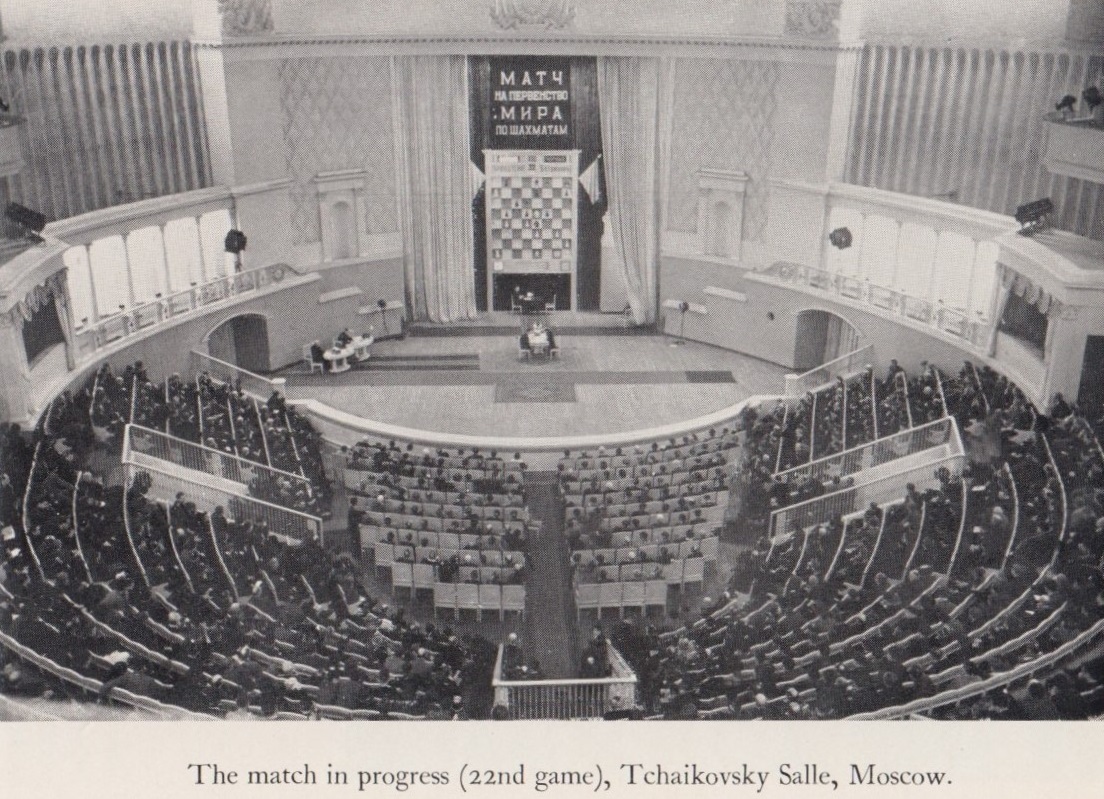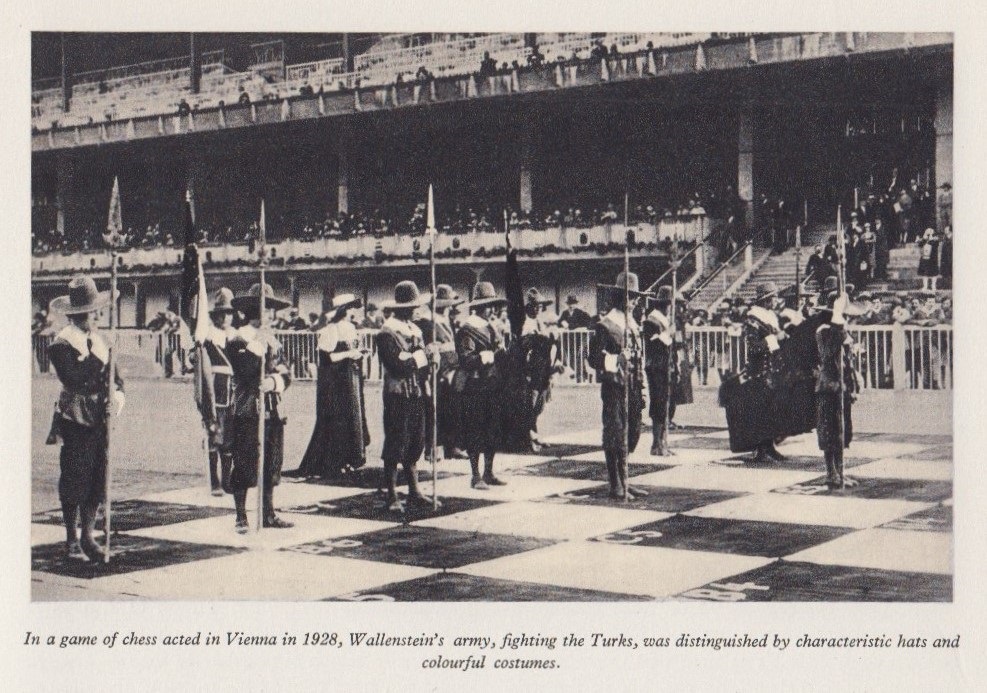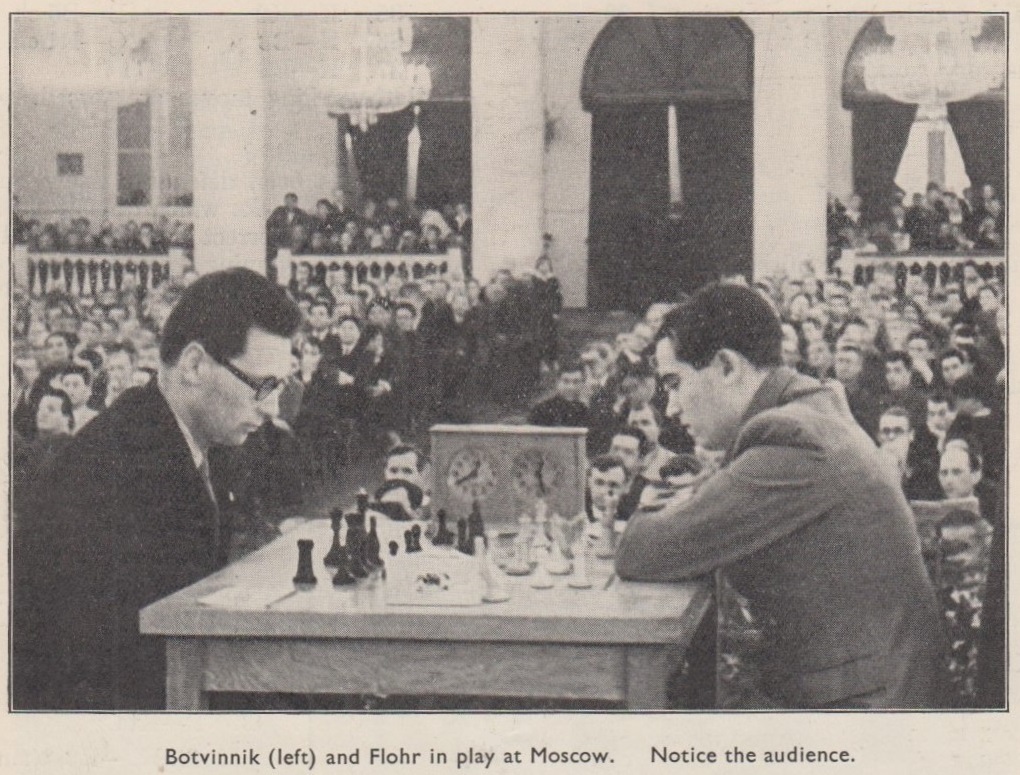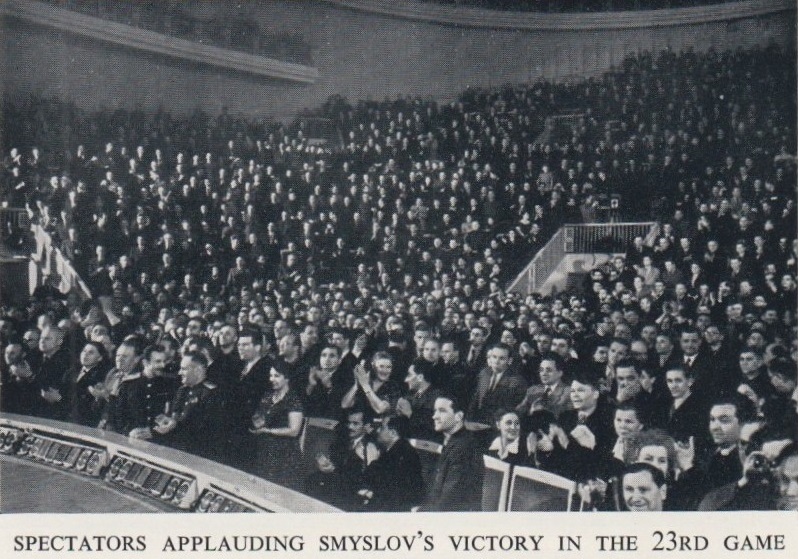
Edward Winter

Photograph opposite page 54 of The World Chess Championship: 1951 Botvinnik v Bronstein by William Winter and R.G. Wade (London, 1951)
Estimates of crowd sizes are notoriously unreliable, but some old reports of high figures at chess events may be tentatively noted here.
a) ‘Probably the largest crowd that has ever witnessed a chess fight assembled to witness the closing game of the contest between Chigorin and Steinitz at Havana on 28 February. It is estimated that about 1,900 people were present at the Centro Asturiano during the progress of that game.’ (International Chess Magazine, December 1891, page 370.)
b) Capablanca reported: ‘The tournament [Moscow, 1925] was played at the Hotel Metropole, a very spacious building ... It can comfortably take 1,200 people, yet it was crowded. There were always 1,500 to 2,000 spectators.’ (Interview in Diario de la Marina, 19 January 1926, page 17.)
Page 92 of the February 1926 BCM gave another participant’s estimate: ‘Yates says that there were about 5,000 visitors per day at the congress.’
c) Regarding Capablanca’s simultaneous exhibition against 200 players at 50 boards in New York on 12 February 1931: ‘ Conservatively estimated, upward of 2,000 persons attended this outstanding performance, unique even in the colorful career of the Cuban master ...’ (American Chess Bulletin, March 1931, page 45.)
d) Moscow, 1936: ‘According to Reuter’s report, so great was the eagerness to see the play that every one of the 2,000 seats in the hall were occupied, standing-room was jammed with spectators, and crowds outside clamoured for admission.’ (BCM, June 1936, page 282.)
‘100,000 people had to be refused tickets of admission to the first round of the Moscow tournament.’ (CHESS, 14 November 1936, page 87.)
At the other end of the scale, page 193 of Warren Goldman’s Carl Schlechter! Life and Times of the Austrian Chess Wizard gives an account from the Wiener Allgemeiner Sportzeitung of the attendance at Monte Carlo, 1904 (participants: Maróczy, Schlechter, Marshall, Gunsberg, Marco and Swiderski). The report claimed that the top attendance was on the final day, with 11 onlookers, whereas only three had watched the first round’s play.
(Kingpin, 1997)
Pages 210-211 of the July 1928 Deutsche Schachzeitung gave the following game of living chess, reporting that there were 2,000 spectators:
B. Lichtenstein – Ernst Grünfeld
Trabrennplatz, Vienna, 6 June 1928
Philidor’s Defence
1 e4 Nf6 2 Nc3 e5 3 Nf3 d6 4 d4 Nbd7 5 g3 g6 6 Bg2 Bg7 7 h3 c6 8 Be3 Qa5 9 dxe5 Nxe4 10 O-O Nxc3 11 bxc3 dxe5 12 Qd6 Qd5 13 Qb4 Qe6 14 Rae1 Qe7

15 Nxe5 Bxe5 16 Bd4 c5 17 Bxe5 cxb4 18 Bxh8 Ne5 19 Bxe5 Be6 20 cxb4 Qxb4 21 Rb1 Qc5 22 Bxb7 Rd8 23 Bf6 Rd6 24 Bg2 Qf5 25 Rb8+ Kd7 26 Rb7+ Kc8 27 Rfb1 Bd5 28 Rb8+ Kc7 29 Be7 Rb6 30 R8xb6 axb6 31 Bxd5 Qxd5 32 Re1 Qd2 33 Re3 Qxc2 34 a3 Qd1+ 35 Kg2 f5 36 Bg5 Qh5 37 h4 Kd6 38 Bf4+ Kd5 39 Rb3 Kc6 40 Be3 b5 41 Rc3+ Kb7 42 f3 g5 Drawn.
(Kingpin, 1998)
For a claim by Edward Lasker that ‘over 5,000 onlookers’ were at his game of living chess against Alekhine in Chicago on 19 June 1933, see C.N. 8917.
From page 195 of A History of Chess by Jerzy Giżycki (London, 1972):

A photograph taken at Moscow, 1925 (Capablanca v Bogoljubow) is reproduced in Analytical Disaccord. The vast popular interest in the tournament is shown by the film Chess Fever.
On pages 13-14 of Last Lectures (New York, 1966) Capablanca wrote:
‘Several years ago, in the Russian city of Kiev, I ran across Andrés Segovia, the great Spanish guitarist. We had known each other for some time; he as a lover of chess, and I as a lover of music! He was to give a concert and I a simultaneous exhibition. Both of these events were to take place in the great concert hall of Kiev, and naturally each of us invited the other to his performance. The simultaneous exhibition had been arranged for 30 students, boys and girls between ten and 16 years of age. Segovia, his wife and I arrived in the hall in due course, and I noted Segovia’s amazement at the spectacle which met his eyes. The huge hall was completely filled, and its balcony held more than a thousand girls who had come to watch the play. All were students and had learned to play chess in their respective schools. On the stage 30 boys and girls had been seated in a rectangle as is customary in such exhibitions. Most of them were boys, all of them ready to do battle with me. In each corner there had been placed a particularly strong adversary. In back of the players there was a crowd of boys and girls with their teachers and in back of them the guests. It was truly, as Segovia said, a phenomenal spectacle. There were at least three thousand people in the hall, almost all of them children.’
(7893)
From page 416 of CHESS, 14 July 1936:

The next picture is from page 74 of World Chessmasters in Battle Royal by I.A. Horowitz and Hans Kmoch (New York, 1949), a book on ‘the first world championship tourney’:

The photograph below comes from opposite page 63 of World Chess Championship 1954 by H. Golombek (London, 1954):

To the Chess Notes main page.
To the Archives for other feature articles.
Copyright: Edward Winter. All rights reserved.